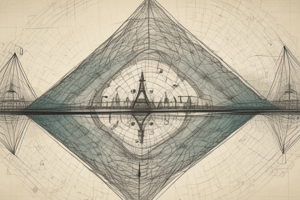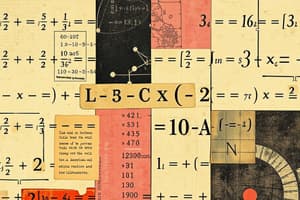Podcast
Questions and Answers
What is a literal equation?
What is a literal equation?
An equation containing more than one variable
A literal equation has only one variable.
A literal equation has only one variable.
False (B)
Solve for y in the equation x + a = yb.
Solve for y in the equation x + a = yb.
y = (x + a)/b
Solve for c in the equation ab + c = 5.
Solve for c in the equation ab + c = 5.
Solve for y in the equation xy + p = 5.
Solve for y in the equation xy + p = 5.
Solve for b in the equation ab + c = d.
Solve for b in the equation ab + c = d.
Solve for a in the equation ab + c = d.
Solve for a in the equation ab + c = d.
Solve for b in the equation 3a + 2b = c.
Solve for b in the equation 3a + 2b = c.
Solve for c in the equation 3abc + b = 5.
Solve for c in the equation 3abc + b = 5.
Solve for p in the equation i = prt.
Solve for p in the equation i = prt.
Solve for L in the equation P = 2L + 2W.
Solve for L in the equation P = 2L + 2W.
Flashcards are hidden until you start studying
Study Notes
Literal Equations Overview
- A literal equation involves two or more variables.
- It is incorrect to say a literal equation has only one variable.
Solving Literal Equations
- For the equation ( x + a = yb ), solving for y results in ( y = \frac{x + a}{b} ).
- The equation ( ab + c = 5 ) can be solved for c as ( c = 5 - ab ).
- When solving ( xy + p = 5 ) for y, the solution is ( y = \frac{5 - p}{x} ).
- The equation ( ab + c = d ) yields ( b = \frac{d - c}{a} ) when solved for b.
- To solve ( ab + c = d ) for a, the equation becomes ( a = \frac{d - c}{b} ).
- In the equation ( 3a + 2b = c ), solving for b gives ( b = \frac{c - 3a}{2} ).
- Solving ( 3abc + b = 5 ) for c results in ( c = \frac{5 - b}{3ab} ).
- For the equation ( i = prt ), solving for p leads to ( p = \frac{i}{rt} ).
- In the perimeter equation ( P = 2L + 2W ), solving for L results in ( L = \frac{P - 2W}{2} ).
Studying That Suits You
Use AI to generate personalized quizzes and flashcards to suit your learning preferences.




